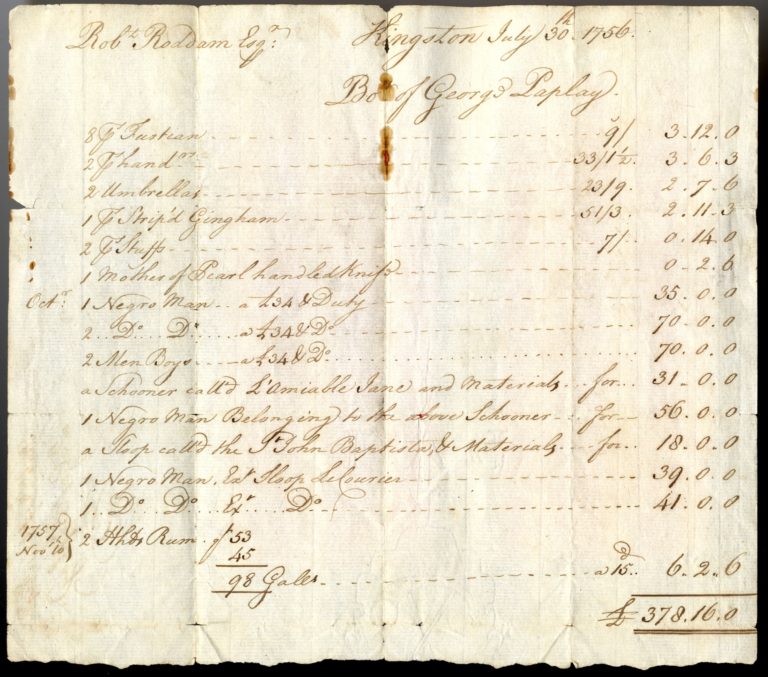Bill Listing Items Bought By Robert Roddam From Paplay in Kingston, Jamaica
Reference: NRO 00329/F/1/2/4/5
Suggested age groups: KS2, KS3, KS4, Lifelong Learners
Subject areas: Slave Trade, Consumerism, Empire
CONTEXT
Born at Roddam Hall in Northumberland, 1719. Died at Morpeth in 1808. Officer in the Royal Navy. His ship, the Greenwich, was captured off Cape Cabron (Dominican Republic)* by the French on 16 March 1757. He was imprisoned, along with his crew at Cape-Francais (Haiti)*, but after several months the French released Roddam and his crew to Jamaica.
The Navy court-martialled Roddam on Jamaica for losing his ship. Roddam was “honourably acquitted”. He continued in the Navy until about 1790 when he returned to Northumberland. He had inherited the Roddam estates in 1776 when his older brother died.
*The Dominican Republic and Haiti are part of the same Caribbean Island, which was often referred to as Hispaniola or Saint-Domingue. The French colonised the island in the seventeenth-century.
Merchant and slave holder on Jamaica. His will (see link below) shows that he was an incredibly wealthy man; he left bequests of £1000s to each of his children. At the time of his death, his estate claimed ownership of 616 enslaved people.
The total for this bill is worth over £84,000 in 2020, according to the Bank of England Inflation calculator. The enslaved men and boys on this bill are valued at £35 each. This is worth about £8,000 in 2020.
Documents from the eighteenth-century regularly use language that is unacceptable. People of African descent were often called “negroes”, as in this bill.
Fustian – thick, hard-wearing fabric
Stiped gingham – medium-weight woven fabric
Stuff – woven fabric, usually made from wool threads
Schooner – type of ship
Sloop – type of ship
Duty – tax
ACTIVITIES
ACTIVITY 1
Background
This bill lists items bought by Robert Roddham from George Paplay in Kingston, Jamaica in 1756, including the sale of enslaved people.
SEE
See: What does this document show?
See: What is recorded as being sold in this bill?
See: What is the total value of the bill?
See: How much were the enslaved people sold for?
THINK
Think: What is the difference between value and worth?
Think: What is the value of a human life?
Think: Why were the enslaved people referred to as “negro man” and not by name?
Think: What does not using the men’s names imply?
Think: How does it feel seeing a price value placed on a person’s life?
Think: How would you feel if a price value was placed on your life?
DO
Do: Look at the bill without context for 10 seconds. What do you notice first? Feed back to the group.
Do: Look at the bill without context for one minute. Try to decipher it. What more do you understand about it now? Feed back to the group.
Do: Look at the bill without context for five minutes. Try to decipher a bit more and think about what we could infer from the record. Feed back to the group.
Do: After your final time feeding back to the group, write a short paragraph summarising what you have found out and inferred from the bill. Compare this to the context. How accurate was your understanding of the document?
Do: Use the Bank of England inflation calculator to work out how much the enslaved people were sold for.
Do: Work out what you could buy today for the same price that the enslaved people were sold for.
Do: Discuss what this document says about the value placed on the the lives of people of African descent in the Caribbean at this time.
Do: Discuss the implications of the phrasing of the enslaved people “belonging” to boats. Does this imply that the boat is more valuable?
Do: Debate whether George Paplay was a bad person. What can you imply about him from his wealth and this bill?
Do: Discuss contested heritage. Should places such as Roddham Hall still carry the names of slavers and should slavers be commemorated?
Resources
ACTIVITY 2
Background
This bill lists items bought by Robert Roddham from George Paplay in Kingston, Jamaica in 1756, including the sale of enslaved people.
SEE
See: How many enslaved people were sold in this bill?
See: How much were the enslaved people sold for?
Think: Who sold the enslaved people?
Think: Who bought the enslaved people?
THINK
Think: What happened to enslaved people when they were sold?
Think: Were different enslaved people valued differently?
Think: How were enslaved people sold?
Think: How were enslaved people prepared for auction?
Think: Who bought enslaved people?
Think: Who sold enslaved people?
Think: Who benefitted most from slavery?
DO
Do: Research how enslaved people were treated prior to and at auctions. Use case studies of individual cases. What can you learn about the treatment of enslaved people from these accounts?
Do: Create a timeline showing an enslaved person’s journey from forced transportation to auction.
Do: Using your research about slave auctions, write an article from the perspective of someone there at the time raising concerns over the treatment of enslaved people.
Do: Discuss how slave owners might have responded to these concerns based on business, moral and cultural justifications from the time.
Do: Research slave auction posters and sale records. What can you learn from these documents?
Resources
https://www.bbc.co.uk/bitesize/clips/z366n39
https://www.bbc.co.uk/bitesize/guides/zqv7hyc/revision/10
https://www.liverpoolmuseums.org.uk/archaeologyofslavery/slavery-caribbean
https://www.nytimes.com/interactive/2019/08/19/magazine/history-slavery-smithsonian.html
https://www.smithsonianmag.com/smart-news/horrors-great-slave-auction-180962287/
http://nationalhumanitiescenter.org/pds/maai/enslavement/text2/slaveauctions.pdf
http://slaveryandremembrance.org/collections/object/?id=OB0042
OTHER ONLINE RESOURCES
University College London Legacies of Slave Ownership project website, page for George Paplay: https://www.ucl.ac.uk/lbs/person/view/2146640751
Jamaican Family Search website, page of wills including the will of George Paplay: http://www.jamaicanfamilysearch.com/Members/w/wills-31.htm
Wise Geek website, page about “stuff” fabric: https://www.wise-geek.com/what-is-the-fabric-called-stuff.htm
Historic England website, page for Roddam Hall: https://historicengland.org.uk/listing/the-list/list-entry/1042364
Geograph website, page for Roddam Hall: https://www.geograph.org.uk/photo/1844306


